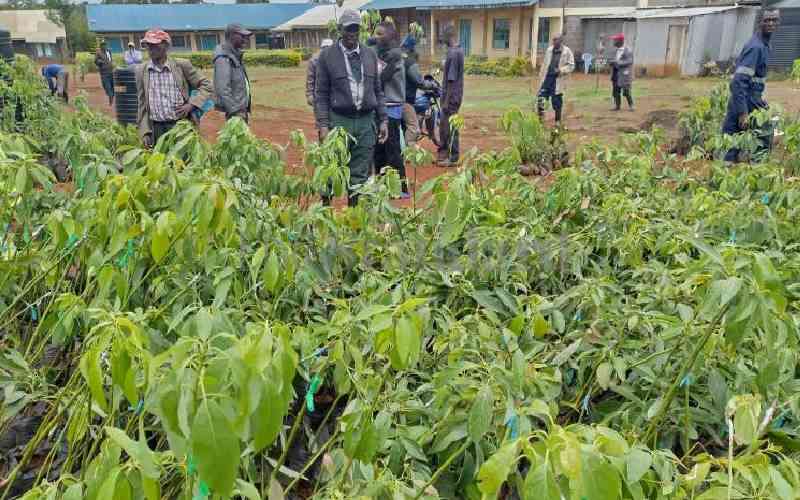Gender equality, equity or parity is an important, sensitive but somehow confusing issue here in Kenya and across different societies.
Following the adoption of the Constitution (hailed as among the best and most progressive in this part of the world) in 2010, the gender issue took a new angle.
There is no doubt the adoption of the Constitution with its strong emphasis on human rights and gender equality is crucial for Kenya's future economic and social development.
The basic law provides that both men and women must be given equal opportunities to improve their lives and contribute to the country's development.
While the Jubilee Government is committed to the rapid social and economic development of this nation, gender equity in Kenya remains a sensitive issue due to some cultural practices and other traditional inhibitions.
For many years, women have been socially and economically underprivileged; a factor that has been a major hindrance to the rapid economic development of our country.
Social norms that condone violence against women and girls, prevent them from full and equal participation in social, economic and political life.
Some traditional practices and cultural practices prevent the transformation of gender power relations, which are necessary to realise substantive equality for women.
Heavy, intense and mostly unpaid work, which includes family care, continues to limit women's full enjoyment of human rights, while violence against women and girls persists in many forms.
However, looking at the broader political, social and economic contexts, there has been some marked progress since the Beijing World Conference on Women, with the creation of an enabling environment on various aspects of gender equality in Kenya and around the world.
However, numerous challenges still exist in several areas towards the achievement of the goals set in Beijing.
On issues such as girls' education, women's labour market participation and women's political participation, there have been efforts to adopt laws to promote gender parity and address violence against women and girls.
There has also been a notable endeavour in the advancement of the global women's peace and security agenda.
The Government is fully committed to gender equality and the empowerment of women as envisioned and espoused in the Constitution of Kenya (2010), to entrench and promote women's full involvement in leadership and development.
The Constitution recognises gender equality and endorses the Two-Thirds Gender Law, which guarantees equal representation of women in both elective and appointive positions, at the two levels of government.
Stay informed. Subscribe to our newsletter
Measures have been taken to ensure women's equal access to and full participation in power and decision-making in the three arms of government.
In this regard, Kenya has made great strides by increasing the participation of women in key decision-making forums.
In order to meet the Constitutional requirement on the two-thirds principle on gender representation in political positions, a Technical Working Group was established to develop a framework for its implementation and this process is ongoing.
The Government has been especially deliberate about the economic empowerment of women, youth and persons with disabilities (PWD).
In this regard, the Government has set up initiatives to make available capital financing for the three groups, which include the Women Enterprise Fund (WEF), UWEZO (Ability) Fund, the Youth Enterprise Fund (YEF), while also providing access to public procurement, through the 30 per cent Public Procurement Initiative.
The 30 per cent Affirmative Action policy in public procurement, is the first such initiative globally, aimed at providing a unique opportunity for women, youth and persons with disabilities to access Government procurement opportunities which had hitherto been out of reach to these groups.
By empowering women and youth, Kenya will be in a position to achieve its development goals and targets. Women must be included in all areas of our national development since they constitute half the population and are a major and vital segment of our national population.
Achieving gender equality in the post-2015 context, therefore, will require the transformation of systems and structures of national machineries to become more deliberately gender-centric to reduce inequalities and vulnerabilities, in order to realise the human rights of all.
As part of the 20-year review of the Beijing Platform for Action, it is important to understand the strategies and mechanisms that women's rights advocates have deployed to make States more accountable on women's rights and why more progress is seen in some areas of gender equality, while there is less progress in others.
Close evaluation and review of the progress made globally in gender equality shows although much has been achieved, progress has been slow and uneven.
Major gaps and obstacles still remain in the implementation of the 12 Critical Areas and Platform for Action.
 The Standard Group Plc is a
multi-media organization with investments in media platforms spanning newspaper
print operations, television, radio broadcasting, digital and online services. The
Standard Group is recognized as a leading multi-media house in Kenya with a key
influence in matters of national and international interest.
The Standard Group Plc is a
multi-media organization with investments in media platforms spanning newspaper
print operations, television, radio broadcasting, digital and online services. The
Standard Group is recognized as a leading multi-media house in Kenya with a key
influence in matters of national and international interest.
 The Standard Group Plc is a
multi-media organization with investments in media platforms spanning newspaper
print operations, television, radio broadcasting, digital and online services. The
Standard Group is recognized as a leading multi-media house in Kenya with a key
influence in matters of national and international interest.
The Standard Group Plc is a
multi-media organization with investments in media platforms spanning newspaper
print operations, television, radio broadcasting, digital and online services. The
Standard Group is recognized as a leading multi-media house in Kenya with a key
influence in matters of national and international interest.








